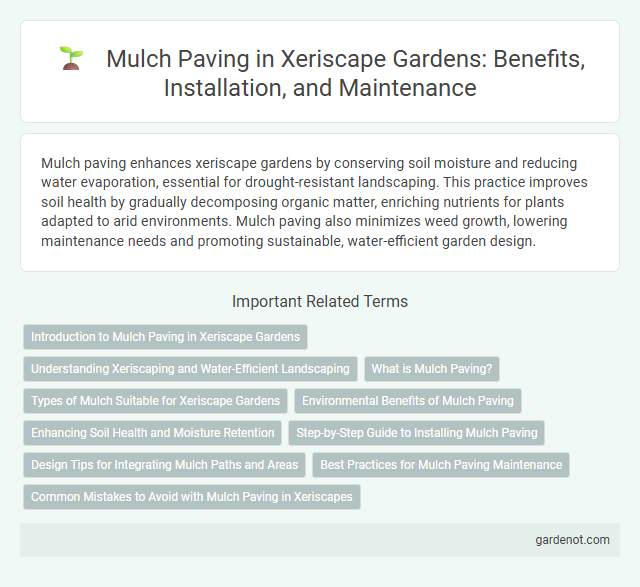Mulch paving enhances xeriscape gardens by conserving soil moisture and reducing water evaporation, essential for drought-resistant landscaping. This practice improves soil health by gradually decomposing organic matter, enriching nutrients for plants adapted to arid environments. Mulch paving also minimizes weed growth, lowering maintenance needs and promoting sustainable, water-efficient garden design.
Introduction to Mulch Paving in Xeriscape Gardens
Mulch paving in xeriscape gardens involves using organic or inorganic mulch materials like wood chips, gravel, or decomposed granite to create permeable, water-efficient walkways and ground covers. This technique conserves soil moisture, reduces erosion, and minimizes water runoff, enhancing drought tolerance in arid landscapes. Mulch paving also suppresses weeds and stabilizes soil temperature, making it a practical and sustainable choice for xeriscaping.
Understanding Xeriscaping and Water-Efficient Landscaping
Mulch paving in xeriscaping enhances water retention by reducing soil evaporation and suppressing weed growth, essential for water-efficient landscaping in arid regions. Using organic mulches like bark or wood chips improves soil health and moisture conservation, contributing to sustainable garden maintenance. This technique supports xeriscape principles by minimizing water usage and promoting plant resilience in drought-prone environments.
What is Mulch Paving?
Mulch paving is a sustainable landscaping technique that involves covering the ground with organic or inorganic mulch materials to enhance soil moisture retention and reduce erosion. Common mulch materials include wood chips, bark, gravel, and decomposed granite, which create a permeable surface allowing water infiltration while preventing weed growth. This method supports xeriscaping by minimizing water use and maintaining healthy soil conditions in arid environments.
Types of Mulch Suitable for Xeriscape Gardens
In xeriscape gardens, organic mulches like wood chips, bark, and straw are highly effective for moisture retention and soil temperature regulation, while inorganic options such as gravel and decomposed granite provide durable, water-efficient ground cover resistant to erosion. Choosing mulch types that improve soil health and minimize evaporation helps conserve water, crucial in drought-prone landscapes. Proper mulch application also suppresses weed growth, enhancing xeriscape sustainability and reducing maintenance.
Environmental Benefits of Mulch Paving
Mulch paving significantly improves soil moisture retention by reducing evaporation, which conserves water resources in xeriscape landscaping. This permeable surface enhances groundwater recharge and minimizes stormwater runoff, decreasing erosion and pollution in nearby waterways. Using organic mulch materials also supports soil health by promoting microbial activity and reducing the need for chemical fertilizers.
Enhancing Soil Health and Moisture Retention
Mulch paving in xeriscape landscaping significantly enhances soil health by reducing erosion and promoting microbial activity. The mulch layer improves moisture retention, minimizing water evaporation and maintaining consistent soil hydration for drought-tolerant plants. This method supports sustainable water conservation while fostering a fertile environment that encourages root growth and plant resilience.
Step-by-Step Guide to Installing Mulch Paving
Mulch paving enhances xeriscape designs by improving soil moisture retention and reducing erosion. Start by clearing and leveling the ground, then lay a weed barrier fabric to prevent unwanted growth. Spread a 2-3 inch layer of organic mulch evenly over the area, compact it gently, and ensure proper edging to maintain the mulch boundary for a clean, sustainable landscape feature.
Design Tips for Integrating Mulch Paths and Areas
Mulch paving enhances xeriscape designs by improving soil moisture retention and reducing erosion around drought-tolerant plants. Incorporate natural curves and varying mulch textures to create visually appealing paths that blend seamlessly with native landscapes. Use organic mulch materials like shredded bark or wood chips to maintain soil health and complement the sustainable principles of xeriscaping.
Best Practices for Mulch Paving Maintenance
Regularly replenish mulch layers to maintain a consistent depth of 2-4 inches, which helps retain soil moisture and suppress weeds effectively. Monitor and remove any debris or weeds emerging through the mulch to prevent competition and maintain a clean surface. Avoid overwatering mulch-paved areas to prevent decay and maintain soil aeration, promoting healthier xeriscaped plants.
Common Mistakes to Avoid with Mulch Paving in Xeriscapes
Common mistakes to avoid with mulch paving in xeriscapes include applying mulch too thickly, which can suffocate plant roots and retain excessive moisture, leading to fungal growth. Using inappropriate mulch materials such as non-decomposable plastics or dyed mulch can disrupt soil health and water absorption. Neglecting to replenish mulch layers regularly causes erosion and reduces its effectiveness in moisture retention, impacting drought-resistant landscaping success.
Mulch paving Infographic

 gardenot.com
gardenot.com